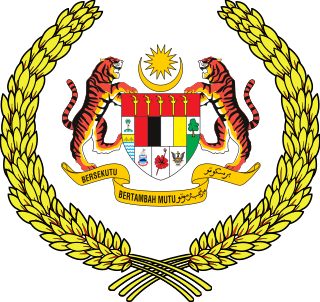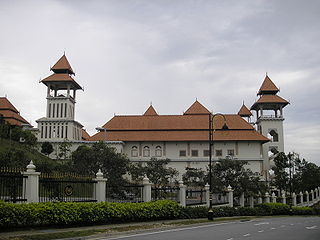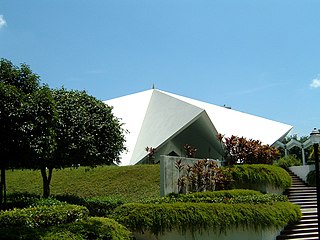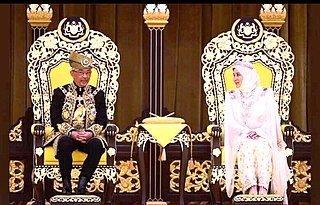
The Yang di-Pertuan Agong, also known as the Supreme Head of the Federation, the Paramount Ruler, or simply the Agong and also unofficially as the King of Malaysia is the constitutional monarch and head of state of Malaysia. The office was established in 1957, when the Federation of Malaya gained independence from the United Kingdom. The Yang di-Pertuan Agong is elected by the Conference of Rulers, comprising the nine rulers of the Malay states, with the office de facto rotated between them, making Malaysia one of the world's few elective monarchies.

The Queen of Malaysia, also known as the "Paramount Consort", is the consort of the Yang di-Pertuan Agong, the elected, constitutional federal monarch of Malaysia.

Al-Mu’tassimu Billahi Muhibbuddin Sultan Abdul Halim Mu'adzam Shah ibni Almarhum Sultan Badlishah was the 28th Sultan of Kedah from 1958 until his death in 2017, the fifth Yang di-Pertuan Agong from 1970 to 1975, and again as the fourteenth from 2011 to 2016. He was the first and only ruler to reign as Yang di-Pertuan Agong twice, as well as the oldest elected to the office. Immediately prior to his death, he was the second longest-reigning living monarch in the world after Queen Elizabeth II of the United Kingdom.

Tuanku Sir Abdul Rahman ibni Almarhum Tuanku Muhammad was Yang di-Pertuan Besar of Negeri Sembilan from 1933, and the first Yang di-Pertuan Agong of the Federation of Malaya from 1957, until his death in 1960.

Sultan Sir Ismail Nasiruddin Shah ibni Almarhum Sultan Haji Zainal Abidin III Mu’azzam Shah was Sultan of Terengganu from 1945 until his death in 1979, and the fourth Yang di-Pertuan Agong, the constitutional monarch of Malaysia, from 1965 to 1970.

Sultanah Hajah Bahiyah binti Almarhum Tuanku Abdul Rahman was the Sultanah of Malaysian State of Kedah from 1958 until her death in 2003 and served as the fifth Raja Permaisuri Agong of Malaysia from 21 September 1970 until 20 September 1975.
Raja Permaisuri Tuanku Bainun is the former Raja Permaisuri of Perak. She was also the ninth Raja Permaisuri Agong of Malaysia and historically the first commoner ever to be installed as the Raja Permaisuri Agong. She is the widow of the late Sultan Azlan Shah and the mother of the incumbent Sultan Nazrin Shah. She is now styled as Yang Maha Mulia Raja Permaisuri Tuanku Bainun.

The Royal Museum along Jalan Istana was the former National Palace and former residence of the Yang di-Pertuan Agong of Malaysia. It stands on a 13-acre (50,000 m2) site, located on a commanding position on the slope of a hill of Bukit Petaling overlooking the Klang River, along Jalan Syed Putra.

Istana Melawati is the second national palace of Malaysia's Yang di-Pertuan Agong in Putrajaya after the Istana Negara in Kuala Lumpur. It serves as a royal retreat for the Yang di-Pertuan Agong.
This article lists important figures and events in Malayan public affairs during the year 1960, together with births and deaths of significant Malayans.

This article lists important figures and events in Malayan and Malaysian public affairs during the year 1963, together with births and deaths of significant Malaysians. The Federation of Malaya merged with Singapore, North Borneo, and Sarawak to form the Federation of Malaysia on 16 September.

This article lists important figures and events in Malaysian public affairs during the year 1965, together with births and deaths of significant Malaysians. Singapore left the Federation of Malaysia on 9 August.

This article lists important figures and events in Malaysian public affairs during the year 1973, together with births and deaths of notable Malaysians.
This article lists important figures and events in Malaysian public affairs during the year 1974, together with births and deaths of notable Malaysians.

Tuanku Tengku Fauziah binti Almarhum Tengku Abdul Rashid is the current Raja Perempuan of Perlis. She also served as the Raja Permaisuri Agong of Malaysia from 13 December 2001 to 12 December 2006.
The installation of the Yang di-Pertuan Agong is a ceremony that formally marks the beginning of the reign of the Yang di-Pertuan Agong as the Malaysian head of state.
Dato’ Seri Nik Mohamed bin Nik Mahmood is a Director of Kumpulan Senireka Sdn Bhd., a large commercial architecture firm in Kuala Lumpur, Malaysia. Mahmood founded the firm in 1973 after he left the Public Works Department. The firm specializes in commercial highrise buildings, and they have done some significant religious buildings. In the 1970s they were operating in the Brutalist idiom, but they turned to Postmodernism at the end of the century and were responsible for some prominent postmodern buildings in Malaysia, including the Menara Axis, 2002, Istana Negara Baru and the Kompleks Dewan Bahasa & Pustaka.

Jalan Tuanku Abdul Halim, formerly known as Jalan Duta, is a major highway in Kuala Lumpur, Malaysia. It connects Segambut to the Parliament interchange on the Kuala Lumpur Middle Ring Road 1. It was named after the fifth and fourteenth Yang di-Pertuan Agong, Tuanku Abdul Halim Muadzam Shah of Kedah.

The installation of Al-Sultan Abdullah Ri'ayatuddin Al-Mustafa Billah Shah ibni Almarhum Sultan Haji Ahmad Shah Al-Musta'in Billah as the sixteenth Yang di-Pertuan Agong of Malaysia took place in a Malay Royal Ceremony at the Balairong Seri, Istana Negara, Kuala Lumpur on Tuesday, 30 July 2019 at 10 a.m. He was elected earlier by the Malay Rulers in the 251st Special Meeting of Conference of Rulers which was held at Istana Negara on 24 January 2019. The meeting was held upon the abdication of the previous Yang di-Pertuan Agong, Sultan Muhammad V of Kelantan who abdicated from his post on 6 January 2019. Abdullah held the position for a period of 5 years beginning on 31 January 2019.
















